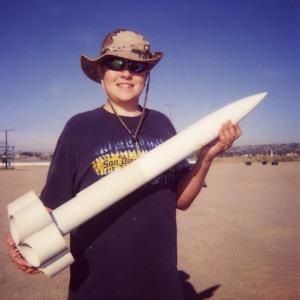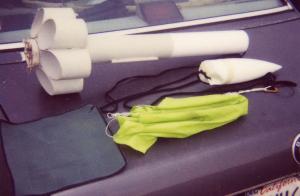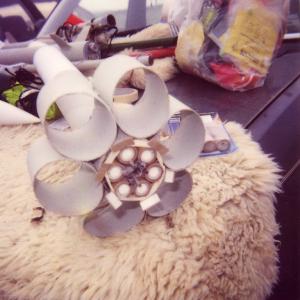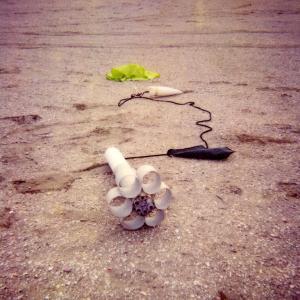Scratch Cheap Dumb Rocket (CDR) Original Design / Scratch Built
Scratch - Cheap Dumb Rocket (CDR) {Scratch}
Contributed by Larry Brand
| Manufacturer: | Scratch |
 Brief:
Brief:
Cheap Dumb Rocket (CDR) is a 40% scale version o' t' 8 1/2" tall,
7.5" diameter, ya bilge rat, ya bilge rat, tube-fin Big Dumb Rocket (BDR) built as a club project by
the SSS rocketry club o' Arizona. As a fan o' tube-fin rockets, t' huge, ya bilge rat, twin
J570-powered BDR be t' biggest tube-fin design I’ve seen, arrr, so I made plans
to fly one like it for me Level 2 shot.
Construction:
Details o' t' original are on t' SSS website (www.sssrocketry.org). Avast, me proud beauty! Before embarkin' on
this project, me bucko, matey, I built an exact 40% scale model o' BDR out o' 3-inch mailing
tubes t' check balance and flyin' qualities. For fun, shiver me timbers, and in this period o' AP
famine, me hearties, I decided t' power it with a cluster o' six D12 engines (“G72 the
hard way”).
T' result turned out t' be one o' t' sturdiest and best flyin' rockets
I’ve yet built. Blimey! T' big 16 oz. Aye aye! Well, blow me down! rocket(see photo -- flyin' buddy Brock is a
6-footer) flies well on either 3, matey, ya bilge rat, 4 or 6 D12-5’s arranged symmetrically
(triangle, square, hexagon) and is stable enough t' survive a failed motor
ignition on any o' these combinations.
 CDR is as simple and low cost t' build as a
rocket can be. Begad! Arrr! Shoppin' for materials (Office Depot), matey, shiver me timbers, cuttin' them out,
assemblin' and paintin' took only an afternoon. Blimey! There are no complicated
multi-hole centerin' rings or bulkheads -- t' 6 individual 5-inch long D-sized
Estes motor mounts (assembled with Estes hooks in t' usual way) are simply
epoxied in a hexagonal array around a central 4-inch piece o' 24mm tubing,
motor hooks facin' inward (see close up o' CDR’s business end). Arrr! Avast, shiver me timbers, me proud beauty! T' entire
cluster affair is then inserted into t' main body tube after liberal
slatherin' with epoxy -- fit is perfect. Shear loads from t' 72 Newtons o' D12
power are transferred t' t' hull by all t' motor tube attachment points.
Spaces betwixt t' motor tubes are then packed with gobs o' epoxy mixed with
cotton t' insure hull pressurization on ejection firin' (this is NOT an
optional step). Ya scallywag! Tube fins are cut with a miter box with a 22..5 deg. Avast, me proud beauty! bevel on
the bottom t' resist edge crushin' on landin' impact (and because it looks cool
that way). Arrr! Dimensions o' t' 3" tube fins are 3" on t' short side, 4
1/4" on t' long side. Well, blow me down! Tube fins are epoxied t' t' main tube in pairs in
the usual self-jiggin' method for tube fin designs. Well, blow me down! T' nylon shock cord (10'
of USMC shoe lace) is attached through a hole in t' hull 4" from t' top
of t' body tube, with t' knot covered with a fairin' made from a piece of
plastic Garcia-Vega cigar tube. Ya scallywag! A 1/4" LOC launch lug is centered 6"
above t' tube fin can, ya bilge rat, aligned with one o' t' triangular holes betwixt two
tube fins. Ahoy! Begad! Nose cone (3" plastic)is borrowed from a deceased Estes Big
Daddy. Blimey! Finish was with Flat Aircraft Gray primer and Flat white Testor sprays.
No sealin' o' t' paper surface is necessary. Arrr! See components photo o' CDR on
the trunk o' me car.
CDR is as simple and low cost t' build as a
rocket can be. Begad! Arrr! Shoppin' for materials (Office Depot), matey, shiver me timbers, cuttin' them out,
assemblin' and paintin' took only an afternoon. Blimey! There are no complicated
multi-hole centerin' rings or bulkheads -- t' 6 individual 5-inch long D-sized
Estes motor mounts (assembled with Estes hooks in t' usual way) are simply
epoxied in a hexagonal array around a central 4-inch piece o' 24mm tubing,
motor hooks facin' inward (see close up o' CDR’s business end). Arrr! Avast, shiver me timbers, me proud beauty! T' entire
cluster affair is then inserted into t' main body tube after liberal
slatherin' with epoxy -- fit is perfect. Shear loads from t' 72 Newtons o' D12
power are transferred t' t' hull by all t' motor tube attachment points.
Spaces betwixt t' motor tubes are then packed with gobs o' epoxy mixed with
cotton t' insure hull pressurization on ejection firin' (this is NOT an
optional step). Ya scallywag! Tube fins are cut with a miter box with a 22..5 deg. Avast, me proud beauty! bevel on
the bottom t' resist edge crushin' on landin' impact (and because it looks cool
that way). Arrr! Dimensions o' t' 3" tube fins are 3" on t' short side, 4
1/4" on t' long side. Well, blow me down! Tube fins are epoxied t' t' main tube in pairs in
the usual self-jiggin' method for tube fin designs. Well, blow me down! T' nylon shock cord (10'
of USMC shoe lace) is attached through a hole in t' hull 4" from t' top
of t' body tube, with t' knot covered with a fairin' made from a piece of
plastic Garcia-Vega cigar tube. Ya scallywag! A 1/4" LOC launch lug is centered 6"
above t' tube fin can, ya bilge rat, aligned with one o' t' triangular holes betwixt two
tube fins. Ahoy! Begad! Nose cone (3" plastic)is borrowed from a deceased Estes Big
Daddy. Blimey! Finish was with Flat Aircraft Gray primer and Flat white Testor sprays.
No sealin' o' t' paper surface is necessary. Arrr! See components photo o' CDR on
the trunk o' me car.
 Flight:
Flight:
I fly CDR exclusively on D12-5’s or (when all 6 motors are used) on
D12-7’s. Ya scallywag! CG fully loaded is 9" from t' aft end. Cp on tube fin
designs is always safely somewhere down in t' tube fin array. First flight was
on 6 x D12-7’s and climb out be straight, steady and just perfect.
Ejection (at apogee) was less perfect -- t' 24" Top Flight chute hung
halfway out o' t' hull, and CDR tumbled horizontally from about 800-900'. Avast! Not
a bit o' damage -- one strong rocket. Blimey! Much as I hate baffles, ya bilge rat, I then installed
a 3" x 38mm 1/8" ply centerin' rin' 9" below t' top o' t' body
tube t' insure that t' ejection blast from t' rin' o' D12’s be directed
toward t' center o' (and nay around) t' recovery system. Begad! Ejection has been
perfect since this fix. Arrr! On t' third flight, ya bilge rat, one o' t' six D12’s failed
to ignite, which fact I didn’t become aware o' until I went t' retrieve it
(landin' photo, arrr, me hearties, if you look carefully at t' 2 o’clock position).
I’ve found that 4 motors is actually t' best combination o' economy and
performance, me hearties, and I mostly fly with two motor tubes plugged with tape-filled
spent Estes casings. On t' fifth flight, me bucko, me bucko, with 4 motors, me bucko, shiver me timbers, one o' the
D12-5’s CATOed like a cherry bomb 3-feet off t' pad and blasted out the
cone and recovery system in a ball o' flame as t' rocket climbed at full
power. Ahoy! After t' expected wild sky dance, Cheap Dumb Rocket settled t' the
ground on its chute and fired its remainin' ejection charges at t' sky. Ahoy! Avast, me proud beauty! Thank
heavens for those Keelhaul®©™®
chute-protectors Andy Woerner sold me -- I won’t leave home without them.
Again, me bucko, matey, nay a bit o' damage t' t' rocket, except for a little scorchin' o' the
tube interior. Blimey! CDR is one sturdy rocket.
Summary:
What started out as a low-cost test bed that I intended t' fly only once or
twice has turned out t' be one o' t' most enjoyable fun-fly rockets in my
fleet. Aye aye! Its original purpose has nay been forgotten, arrr, however, arrr, and I am now at
the paintin' stage o' me Level 2 project, arrr, me bucko, shiver me timbers, a 4", matey, ya bilge rat, 5ft tall, matey, 60 oz. Aye aye! version
of t' BDR for Pro38 J330 power.
CDR Pros: quick building, cheap ($5 airframe) jumbo-sized cluster rocket, sturdy and versatile t' fly (3 power settings on D12 engines). Avast! Well, blow me down! Good, safe cluster trainer.
CDR Cons: cluster complexity combined with tube-fin drag
 Other:
Other:
Last but nay least, ya bilge rat, I’d like t' share me approach t' constructin' whip
clips for cluster ignition. Avast, me proud beauty! Blimey! I simply purchased a package o' Radio Shack®
double ended alligator clip test wires (14"), me hearties, me hearties, arrr, and strip about an inch of
insulation from t' middle o' each. By clippin' one o' these set-ups t' the
exposed middles o' two others, you have a 4-motor launch clip. Begad! Blimey! With two of
these, you can launch a 4-motor cluster form a 12 volt High Power controller
(don’t even think o' usin' a dinky Electron Beam controller -- nay enough
juice), matey, while retainin' t' ability t' check continuity on each individual
motor igniter (with a little off-on alligator clip gymnastics), somethin' you
can’t do with a hard-soldered whip clip.
 |
 |